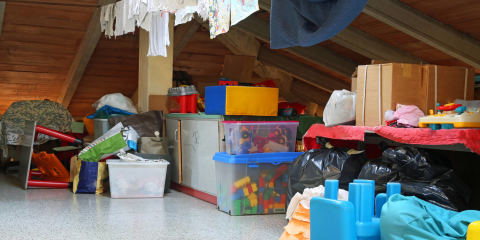Attics are often a dumping ground for items we want to keep out of sight and out of the way. They’re where we hide our clutter—things we don’t use very often, things we just don’t know what to do with, cursed paintings that keep us looking young, etc.—and we usually leave it all there to collect dust, having forgotten these items until we need them or move to a new home.
Organizing your attic space is a great way to free up more storage space for your lower levels, and possibly even create another usable room, but attics present a unique challenge when it comes to storage and organization. These spaces are often unfinished, oddly shaped, and the items stored there are rarely put to use, such as:
- Items used only seasonally, such as holiday decorations
- Inherited family heirlooms, clothes, and boxes of photos—items that may not serve a practical purchase, but which we can’t bear to part with
- Items we don’t know what to do with, so we shove them in the attic for a later day—out of sight, out of mind!
Try these tactics for getting your attic clutter under control:
How To Organize Your Attic
Regardless of what we store in these unique and sometimes odd spaces, the principles you’ll use to organize your attic are the same as those you’d use to organize any other space in your home:
- Start by sorting and decluttering your belongings
- Create zones so it is easier to find the items you are looking for when you need them
- Make use of organizational tools and supplies
PRO TIP: Don’t bite off more than you can chew—organizing your attic is likely a multi-day job. Set aside enough time to properly tackle the task, and don’t rush through it—take breaks as needed
If you use your attic as a living space, such as a bedroom, playroom, work space, or simply extra closet space, be sure to check out these links:
If you use your attic for storage, keep reading:
1. Collect organization & storage supplies
To get your attic under control and organized, you’ll need supplies. Before you dig in, pick up or prepare the following items:
- Trash bags
- Paper shredder
- Permanent markers
- Label maker
- Storage containers
- Shoes—do not tackle this without proper footwear
- Face mask (if your attic is especially dusty or you are sensitive to dust)
- A fan, if your attic isn’t air-conditioned or climate-controlled
- Lighting if necessary
2. Remove everything from the attic
In order to properly sort, declutter, and organize your belongings, begin by taking everything out of your attic if possible. Moving everything into another space will create a more pleasant work environment, as well as give you more space to work with.
PRO TIP: If you can’t move your stuff to another space, consider wearing a mask to filter out any dust and particulates, keep a fan handy, and bring up lots of water (and maybe a snack or two).You could also move everything into one small section to give yourself a more open workspace where you can drag out a few things at a time to deal with.
3. Inspect your space
Once your attic has been cleaned out, inspect the area for pests, damage, and other hazards, such as:
- Loose insulation
- Errant nails or screws
- Loose floorboards
- Mold and mildew
- Blocked air vents
- Insufficient weatherproofing
With your attic cleared out, this is the perfect time to take care of any infestations or repair any weather-related damage you hadn’t previously noticed.
With everything out of the attic, it’s the perfect time to assess what future uses of the space may be viable and get in touch with contractors if necessary:
- If your attic is finished, you could convert it to a play area, extra bedroom, reading nook, or work space.
- If it’s unfinished, now is the time to look into getting it finished and whether or not that’s worth it.
4. Sort
Now that everything is out of the attic or consolidated, it is time to sort it all into piles:
- What to keep: Keep anything you actually use—however irregularly—and items that hold a lot of sentimental value or joy.
- What to sell or donate: If anything is still usable and maybe just a bit dusty, such as kid’s toys or old clothes, clean it off and sell or donate it.
- What to throw out or recycle: Toss anything that is broken, expired, or which otherwise can’t be used.
Once you’ve narrowed down what you’ll keep, sort those items again to get them properly organized. There are a few different methods you can use: sort by size, season, item type, or all three. The best sorting method depends on your attic and the type of items you’re sorting.
PRO TIP: If you have a lot of stuff to trash, consider renting a dumpster to help clear things out faster. If you have a lot of belongings to store, consider renting a storage unit and keeping only items you regularly need access to in your attic.
5. Create zones
With your items sorted, you can create designated zones to determine where each category of items should be stored when you haul everything back up. After working out which storage method will work best for each category type (such as shelving, boxes, plastic containers, etc), group all the containers holding like items together.
When creating zones, we recommend grouping your items into categories such as:
- Frequently (or most frequently) used
- Seasonal items or items used only on special occasions
- Sporadically used
This method will help you place things back in an easy-to-access way, with the most commonly used items being the most accessible.
6. Setting up the space (a.k.a. supplies (again!))
Now that you have an inventory of your belongings and what is going back into your attic, you are ready to purchase and set up your storage solutions. Which storage solution is right for you will be highly dependent on the layout of your attic, but these items may prove to be useful regardless of your situation:
- Rods: Hanging or tension rods can be helpful in the attic for hanging seasonal clothing and other items you’d rather not fold and pack.
PRO TIP: Be sure to protect seasonal clothing from moths and other pests by using zippered garment bags and including a bar of soap or sachet of lavender or cedar chips inside the bag.
- Drawer units: Drawers are ideal for smaller items such as toys, crafts, or hobby items, and you can find easy-to-lift and customizable plastic setups that can be built to suit your needs.
- Shelving. You may even want to install built-in shelf units, or haul up a finished shelving unit to store items like sports equipment or holiday decorations. Here are a couple of things to keep in mind if you opt for shelving:
- Metal or plastic shelving is best (it’s resistant to temperature and moisture fluctuations)
- Be sure to secure shelving units to the wall, especially taller shelves
- You can also add shelves to attic trusses, but only if you plan on storing light or medium-weight items. Anything too heavy will put stress on the truss.
“Regardless of whether you’re using your attic as a storage unit, an office, or a spare bedroom, without shelves or cabinets, you will feel like you’re being buried under a mountain of things. This can be anything from old clothes and used toys to old gadgets! Adding shelves or even buying some new kitchen cabinets is a lifesaving decision. Ready-to-assemble kitchen cabinets can not only be great for storage, but are also very simple to install. Of course, if you add too many things to your walls it can add to the clutter and disorganization, so do so carefully.”
—Ashley Lipman, bestonlinecabinets.com
Safe storage
Attics are not the most stable climate in your home. For this reason, some items you decide to keep in this space may require particular storage solutions to ensure they remain in good condition and free from damage. Here are some rules to follow to ensure your belongings stay safe while in storage:
- Anything paper should be stored in a waterproof, airtight container. You may also want to consider including silica gel packets—you can buy these at several online retailers and in stores, or you could re-use any packets found in old shoeboxes and other packages for items you’ve purchased.
- Small items can be organized into larger containers to make it easier to stay organized, though you might want to label the containers in case you need the item in the future:
- Use transparent containers
- Label the top and the side of the container
- Add the date to the label. This makes it easier to figure out what to get rid of next time you take on the task of reorganizing your attic.
- Bonus points if you color code your bins—one for holiday decor, another for photos, etc.
Extremely climate- and temperature-sensitive items, such as antiques and some artworks, should be removed and kept in your home, sold, or placed into storage at a climate-controlled facility.
Conclusion
Whether you’re moving, setting up a new home, or are simply in need of a bit of organization, get your home organized from top to bottom, starting with the attic:
- Make a plan of attack
- Gather your supplies
- Remove everything from the attic
- Sort and declutter your belongings
- Create zones
- Ensure items going back into the attic have adequate storage protection
- Set up your storage system
- Put everything that’s staying back into its appropriate location in the attic
Get organized!
Control your clutter with our organization guides.




